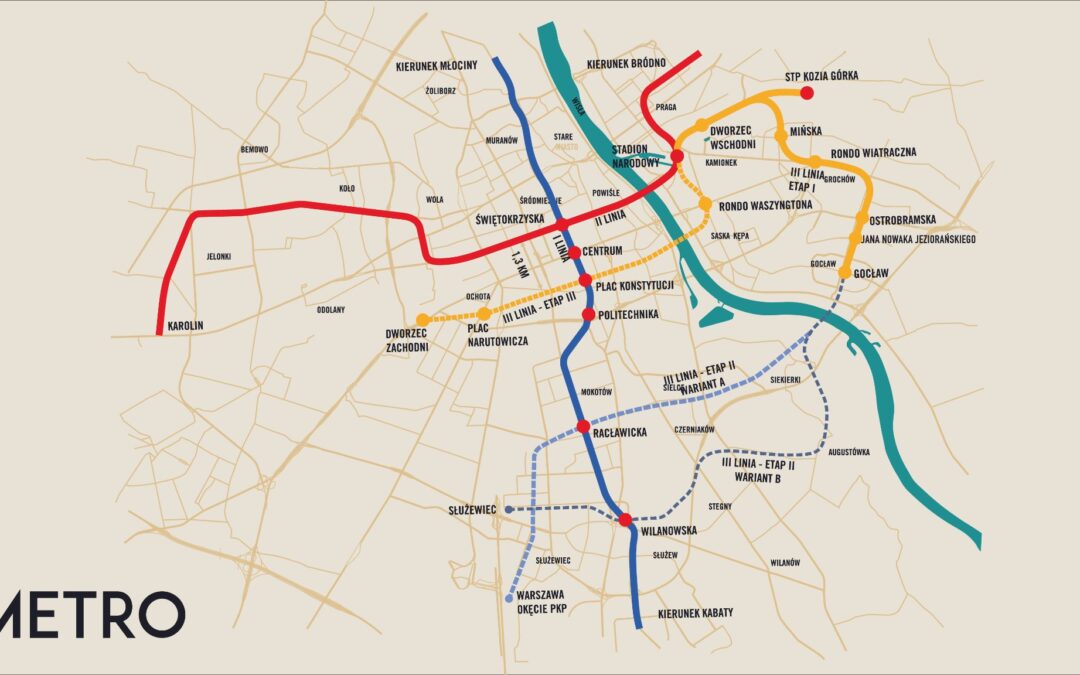The mayor of Warsaw has announced plans to add a third line to the city’s metro system. The new route will connect the city centre with the district of Praga-Południe on the right (east) bank of the Vistula river, and later also with Ochota and Mokotów.
The metro line is part of a wider “New Opening” project that will also include new pedestrian and cycling infrastructure in central parts of the Polish capital.
One of the longest pedestrian and cycle bridges in the world will be built across the Vistula river in central Warsaw, mayor @trzaskowski_ has announced.
The 500m long construction is to cost 180 million zloty and be completed in 2023 or 2024 https://t.co/Kf00XRMKMe
— Notes from Poland 🇵🇱 (@notesfrompoland) March 12, 2021
The first stage of construction, which will run until 2028, will see six new metro stations built on the east bank of the Vistula. The route will run from the existing Stadion Narodowe (National Stadium) station, already open as part of the second (M2) metro line.
The new line will then run towards Warszawa Wschodnia (Warsaw East) railway station, and through Mińska Street, Wiatraczna Roundabout, Ostrobramska Street, Jana Nowaka-Jeziorańskiego Street and finally towards the Gocław subdistrict.
The line is meant to provide the 180,000 people living in Praga-Południe, which is the second-largest district in the capital, with a 17-minute connection to the city centre, according to city hall.
As part of the “New Opening” initiative, plans for a 500m pedestrian and cycle bridge across the Vistula, which is meant to be one of the longest such structures in the world, were announced last week.
Other initiatives include revitalising Pięć Rogów (Five Corners) Square in the city centre and Chmielna Street that runs through it, as well as a tender for the narrowing of the central Marszałkowska Street, which will include more cycle lanes.
“Warsaw is a city…where history meets modernity,” wrote the city’s mayor, Rafał Trzaskowski. “That is why it is so important that we always remember that it consists of two banks [of the river] and that we build as many bridges and connections as possible so that we can stitch and merge it.”
On Monday morning, Trzaskowski, who had pledged the third metro line as part of his campaign for the mayor’s office in 2018, said that preparatory work on the route will begin immediately so as to be included in the European Union’s upcoming funding perspective.
A technical study of the next part of the line, which will cross the river to west-bank districts in southern Warsaw, will begin in the second half of the year.
Trzaskowski added that he will ask the city council to approve funding on Thursday. While the exact amount was not made public, previous city budgets estimated the investment at over 1 billion zloty (€220 million), reports Gazeta Wyborcza.
“It was not an easy decision, because the financial situation of the city is really difficult,” noted Trzaskowski. A number of other long-anticipated east-bank infrastructure projects – including a ring road from Wiatraczna Roundabout to Targówek Fabryczny, a concert hall, and a new tram line in Gocław – have all recently been delayed.
The third line is expected to be used by 315,000 passengers each day, with 26,000 commuters at peak times.
Warsaw’s metro was launched over 25 years ago. Subsequent segments were added to the north-south M1 line in 1998, 2001, 2003, 2005 and 2008. The line is used by about 550,000 passengers each day.
The second line, M2, which began operating along the capital’s east-west axis in 2015, has around 215,000 daily passengers. The completed M2 line is supposed to have 21 stations along 23 km of underground tracks.
However, bureaucratic delays, environmental checks and land disputes mean that the full planned extension may no longer be completed by the 2023 deadline.
Main image credit: Rafał Trzaskowski/Twitter

Maria Wilczek is deputy editor of Notes from Poland. She is a regular writer for The Times, The Economist and Al Jazeera English, and has also featured in Foreign Policy, Politico Europe, The Spectator and Gazeta Wyborcza.




















